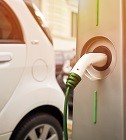There is a growing demand from consumers and investors for environmentally conscious transport options, according to American Century Investments’ Guillaume Mascotto, and, while there are headwinds at the moment, numerous factors are supporting the trend’s growth.
Electric cars have come a long way from the first crude versions built in the mid-1800s. Today they’re a core element to some of 2020’s most successful companies – look no further than Elon Musk’s Tesla for evidence that electric vehicles (EV) have moved from being a niche area to globally competitive businesses.
Meanwhile, traditional auto makers like Volkswagen have deployed billions in the past few years into developing and expanding their EV ranges.
Mascotto, head of ESG and investment stewardship at American Century Investments, said growing demand for EVs is coming in response to concerns about climate change, air quality and depletion of finite natural resources.
This demand for more climate-friendly actions has put pressure on companies “to increase transparency around climate change-related risks, including transition risk,” he said. Transition risk is the one of the headwinds to EVs.
Transition risk is the previously unfactored changes in policy, reputational impacts and changes in market preference that might negatively impact a company and its returns as the world transitions to a low carbon economy.
“For the fossil fuel industry, transition risk means the production and profitability models for extracting fossil fuel assets are no longer viable and consequently stranded,” Mascotto said.
“This shift in business focus results, in part, from changing consumer attitudes, toughened environmental legislation and technological advances.”
The other headwind to EVs at the moment is the coronavirus crisis, which has materially impacted all car sales in 2020 including EVs.
According to data from Bloomberg New Energy Finance (BNEF), car sales are expected to decline 23 per cent in 2020 and won’t recover to 2019 levels until 2025.
“They expect EV sales to drop for the first time in decades,” Mascotto added.
But in spite of that, the growth of EVs has more support than resistance, according to Mascotto, as the world moves towards better climate practices.
Below, American Century’s ESG head gives four trends supporting EV growth.
Shift in consumer preferences
As touched on above, there has been a growing demand for both EV ownership and development.
According to more data from BNEF and its Electric Vehicle Outlook, EV sales went from 450,000 in 2015 to 2.1 million in 2019.
“They will drop in 2020 before continuing to rise as battery prices fall, energy density improves, more charging infrastructure is built, and sales spread to new markets,” the report said.
Mascotto added: “Despite historically low prices for gasoline, sales of battery electric vehicles (BEVs) and plug-in hybrid electric vehicles (PHEVs) continue to accelerate.”
One of the most striking consequences from the coronavirus lockdowns has been the improvement in air quality from reduced vehicle traffic, he continued.
“Asset owners focused on decarbonising their portfolios may take the opportunity to redouble their efforts by arguing that urgently transitioning toward a lower-carbon economy is, in fact, doable. This will likely fuel further support for cleaner transportation options,” he said.
Government policies
While this demand is being driven by the individual consumer, the move to EV has widespread government support. Many countries have created incentives for EV adoption and increased usage, Mascotto said.
“Governments have adopted a push-pull approach to encourage EV usage, offering financial incentives (e.g., tax credits) and issuing new regulations (e.g., mandating carbon emissions reductions).”
An example of this was seen in the European Union (EU), which introduced carbon emissions targets that “require carmakers to meet more stringent average carbon emissions standards or risk significant fines”.
The EU mandated that cars sold there could not emit more than 95g of carbon dioxide per kilometre in 2020, a decrease from 120g/km.
“In an even bolder move, the EU is also planning a Green New Deal, a post-pandemic recovery stimulus plan aligned with significant environmental action. The €500bn to €1trn program includes €80-90bn dedicated to promoting EV adoption and building out charging infrastructure,” Mascotto pointed out.
EV stimulus is also being seen in China, a country responsible for half of the world’s EV usage, he added.
There, restrictions have been made on investment into internal combustion engines (ICEs) production. It mandates that auto companies must offer EV options as a prerequisite for doing business there.
Advances in technology and improving learning curves
One of the concerns raised about EVs is the non-climate friendly methods required to obtain the lithium needed to make the car batteries.
But technological advances, increased production capacity and efficiency advancements of the lithium-ion batteries have helped mitigate some of those concerns, the ESG head said.
Alongside this the cost of both global battery storage electricity and energy prices have dropped, and Mascotto expects the latter to continue falling until 2040.
“Such trends have helped make ownership and operation of BEVs and PHEVs more affordable. In fact, battery storage is now the cheapest new-build technology in gas- importing regions, such as Europe, China and Japan.”
Improving infrastructure
The final factor supporting the investment case for electric vehicles is improvements in the physical infrastructure, namely accessible charging stations.
“Providing accessibility to charging stations remains one of the largest barriers to widespread EV adoption. However, the range of electric batteries has improved, helping reduce drivers’ ‘range anxiety’ around the lower mobility relative to a conventional ICE,” Mascotto said.
Cars are being developed to go for longer in-between charges and the costs for ‘home-based charging stations’ have decreased.
According to the US Department of Energy, the US had more than 68,000 charging stations by the end of 2019 and this is expected to grow. BNEF research says that almost one million charging stations have been installed globally.





